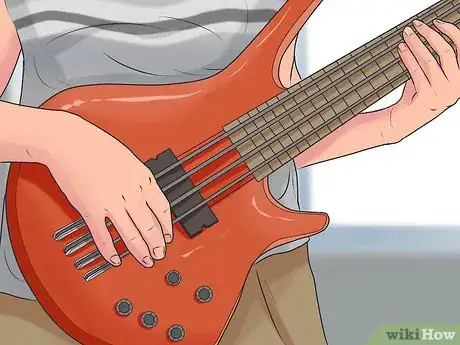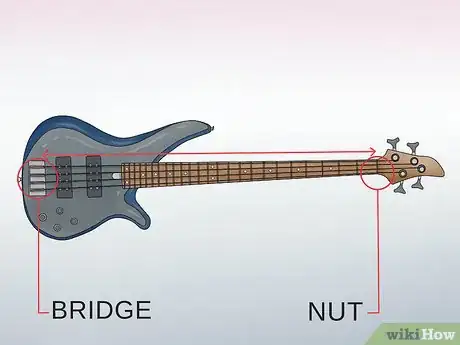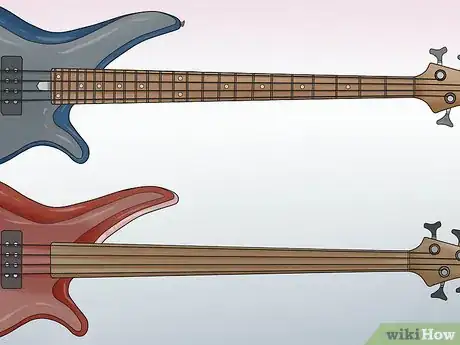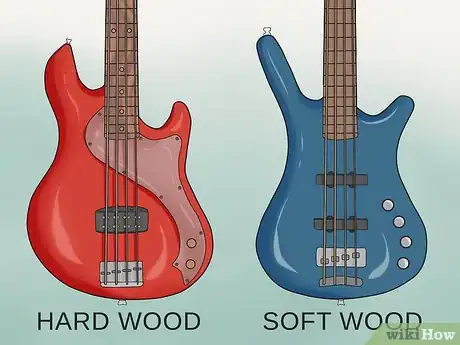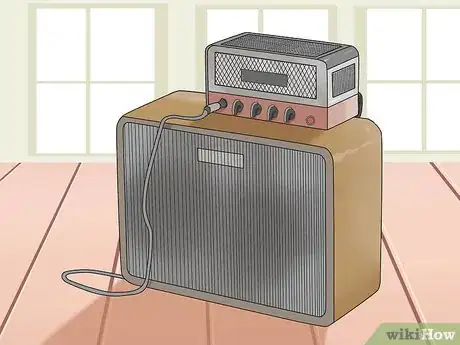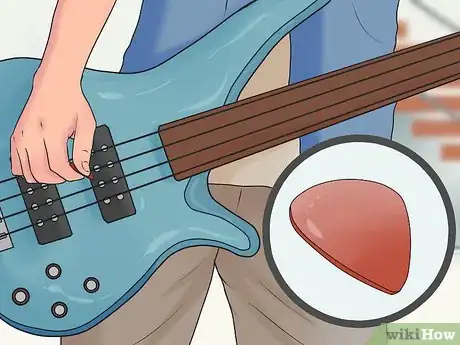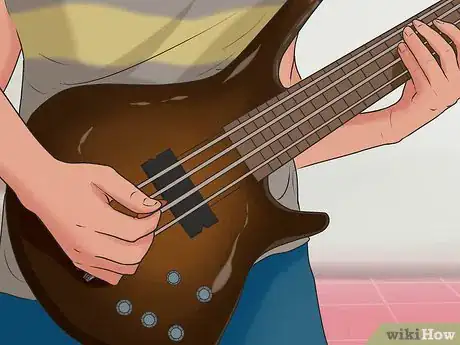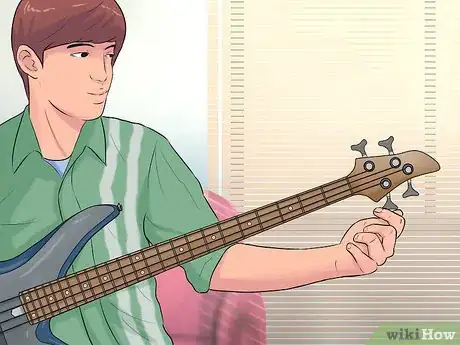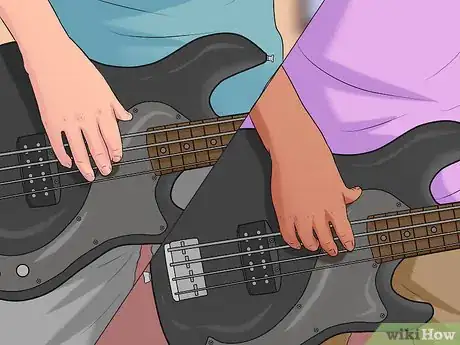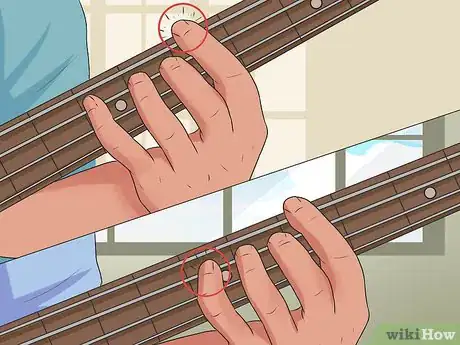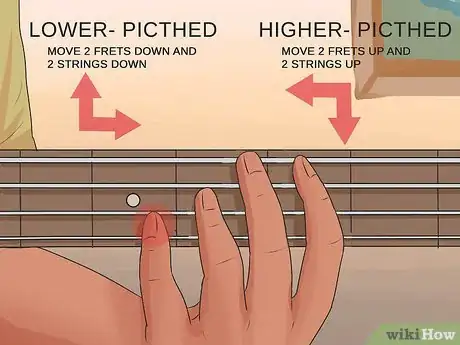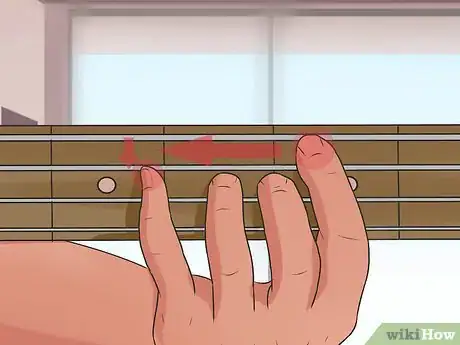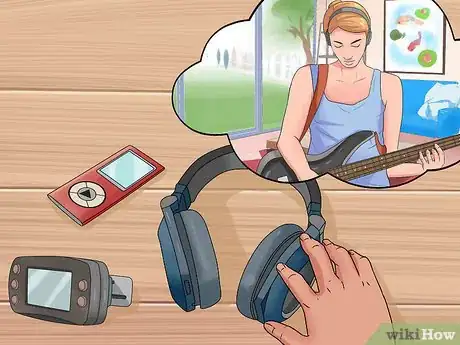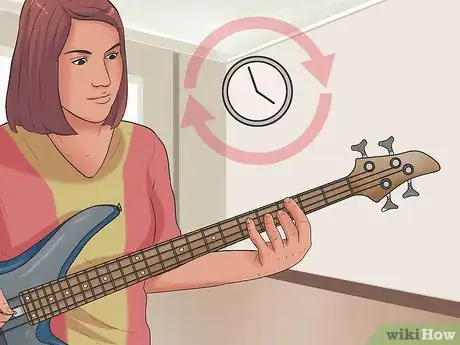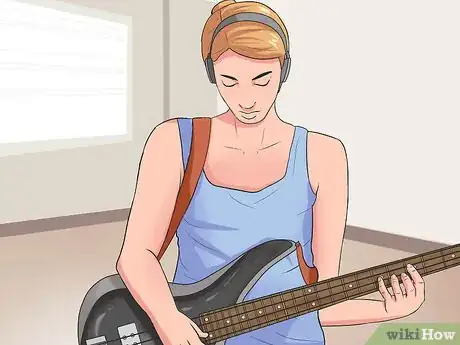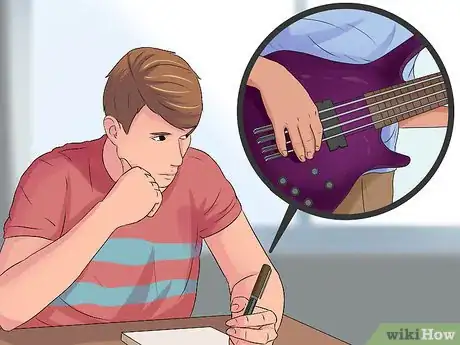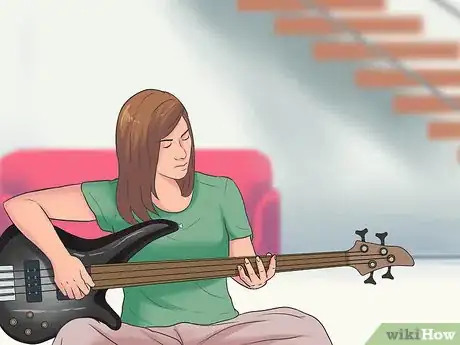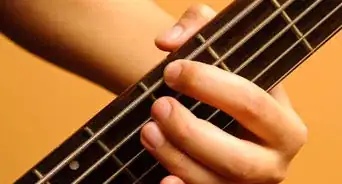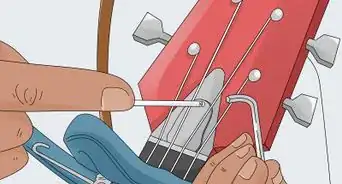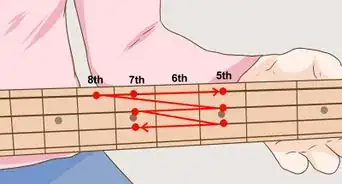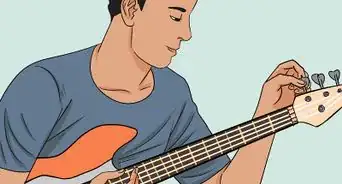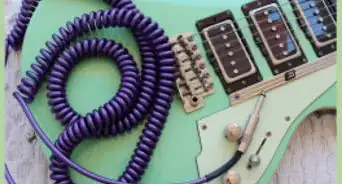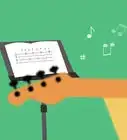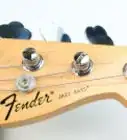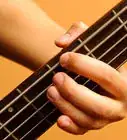This article was co-authored by Nicolas Adams. Nicolas Adams is a 5th generation musician of Serbian Gypsy descent and the lead guitarist of the band Gypsy Tribe. Based in the San Francisco Bay Area, Nicolas specializes in Rumba Flamenco and Gypsy jazz and playing the guitar, Bouzouki, Balalaika, and piano.
There are 11 references cited in this article, which can be found at the bottom of the page.
This article has been viewed 407,646 times.
Learning how to play the bass guitar is a great way to add a little music and rhythm to your life. Although starting an education in a new instrument may seem daunting, teaching yourself the basics can be easy and rewarding.
Steps
Choosing a Bass
-
1Choose the number of strings. Because bass guitars are electric, the body of the guitar can come in nearly any shape or color and still give a great sound. What is important though, is choosing a guitar with the right number of strings for your ability. As a beginner, it is best to start with a classic 4-string bass guitar.
- The original bass guitar was made with 4 strings, and is considered the most basic. Nearly all bass guitar music can be played on a 4-string guitar, and because the neck is narrower than a 5 or 6 string guitar, it is easier to work your hands around.
- A 4-string guitar is typically strung with the EADG strings, but if you want, it can be strung like a 5-string guitar with a lower string making it BEAD instead.
- 5-string and 6-string guitars are great because they give a greater range of available notes to play. However, they also require more control to reduce the buzzing of other strings and the ability to reach all the notes.[1]
-
2Select a scale. The scale of a bass guitar refers to the distance from the nut to the bridge, essentially the length of the guitar strings. A longer scale will have longer string length and produce a deeper sound. A shorter scale may be easier to maneuver for a beginner, but will lack the depth of sound a long scale bass will have.
- Most bass guitars have a 34” scale, but you can also find short scale (30” or less), medium scale (30”-33:), and extra long scale (35” or more) bass guitars.
- Unless your hands are very small or very large, stick with a 34” scale for the best sound.
- If you decide to get a 5-string or 6-string bass guitar, increase the scale for a better sound. Always get a minimum 35” scale if you increase the number of strings.[2]
Advertisement -
3Decide on fretted or fretless. Frets are the metal dividers in the fingerboard. Frets mark where different notes on a string can be played (by pushing a string against it), and are found on all guitars. However if you are buying a bass guitar, you have the option to go fretless.
- A fretless guitar does not have the metal dividers, and instead has a long, smooth fingerboard.
- Fretless guitars are more difficult to play because you don’t have a visual marker of where certain notes lie. Instead, you have to play the bass by ear.
- For beginners, it is best to choose a guitar that is fretted, to give some guidelines for note and finger placements. Over time, you can choose to move to a fretless guitar for a bigger challenge and a slightly different sound.[3]
-
4Choose a material. Bass guitars are made out of many different materials, including different types of hard and soft woods, and composite or synthetic materials. Although each material gives the bass a slightly different appearance and sound, as long as the instrument is solid and well built, the material the bass is made from isn't a major factor to choosing your bass. Either way, here are some characteristics of different materials.
- Hard woods, such as hard maple, walnut, ebony, and rosewood, give a percussive sound to your bass.
- Soft woods including alder, basswood, and swamp ash, aid in supplying your bass with a softer, warm sound.
- The most popular synthetic material to make bass guitars out of is graphite, although luthite is another commonly used material. These are all very consistent in mass production, as the material doesn’t change from guitar to guitar like it does with natural woods.
- Many bass guitars are made from a mix of materials, especially having the body of one material and the fingerboard of another. This is a good option as well, so don’t feel the need to search for a single-material bass only.[4]
-
5Find an amp. In order to play bass, you need to have an amp to plug your bass, so that you can hear yourself play. An amp has three main components: the power amp, preamp, and speaker cabinet. The easiest way to get all three is to buy a combo amplifier. Although these may lack the power for a louder sound of bigger amps, they are very easy for beginners to use. The biggest advantage of having separate pieces of gear, is that you can choose each one to match your personal taste. You should start with a small combo amp, if you find the need to upgrade it later on your bass journey, you will know better what to look for on a higher-end amplifier.[5]
-
6Decide if you'll play with your fingers or with a pick. Playing with fingers gives the "traditional" bass sound, and allows for many finger exclusive techniques, while playing with a pick will make the sound brighter and more agressive (hence many rock/metal players use them), allowing for more guitar-like techniques. Many people recommend to learn to play both ways, you'll be a more versatile player overall.
Playing the Bass Guitar
-
1Hold the bass correctly. In order to make the best music you can, it is important to have it in the proper position. You should always use a shoulder strap to hold the bass so that when you are playing your hands can focus on making the sounds you want to hear.
- You can sit or stand up, but make sure that you have good posture in either position.[6] Also, make sure that the shoulder strap holds your bass at the same level regardless of whether you are sitting or standing.
- The bass should be held somewhere between your hips and collarbones. Most people tend to play with it held near their bellybutton, but it’s all personal preference.
- The guitar should be held at about a 30 degree angle, so as to prevent the need to uncomfortably angle your wrists so much.[7]
-
2Tune your bass. The standard tuning on a 4-string bass guitar is E-A-D-G, with E being the low string and G being the high string. You can learn how to tune your guitar by ear, which is often inexact, or plug your bass into an electric tuner, which is more exact. To make a string go up or go down in pitch, turn the tuning heads, also called tuning machines.
-
3Practice your plucking. The bass guitar, unlike other guitars, is only ever plucked rather than strummed. It is important to maintain good plucking practices though, to create the best sounding music. The bass can be picked like a guitar as well, which is a matter of musical preferences.
- Always keep your nails trimmed short. Your nails will change the sound of the guitar if used against the strings.
- Pluck using two fingers to increase efficiency. Alternate plucking between your index and middle finger. It doesn’t matter which you start with, as long as you keep the speed and rhythm between them consistent.
- Pluck the strings closer to the neck for a flat, warm tone. If you pluck nearer to the bridge at the bottom, the strings will give a more percussive sound. When you practice, keep your plucking isolated to a small area without a lot of movement up and down the strings.
- Pluck the strings by rolling over them with your fingertips. Don’t actually pull on the strings, as they won’t create as nice of a sound. If you want to increase the volume, turn up your amplifier, not your plucking strength.
-
4Mute the strings that aren’t being played. In order to give a clear sound and avoid muffling the notes you play, it is necessary to mute the strings by resting a finger on them.
- Keep your thumb as close to the E string as you are able, so that whenever you are not playing it your thumb can rest on it to do the muting.
- If you have to skip strings to play multiple notes, try using multiple fingers to help with muting.
- You can choose to move your thumb off the E string to mute other strings if you are playing higher strings.
- Don’t push down hard on the strings, but gently rest your finger or thumb on them to block the vibrations that cause sound.[8]
-
5Learn how to play roots. Roots are the main note that a chord is based off of. A chord is playing multiple strings at once, and the root is the note for which the chord is named. Typically, you will start playing the bass simply by focusing on playing the roots to chords.
-
6Learn how to play octaves. All music is made up of 12 notes, which can be played in higher or lower versions. The higher or lower version of a single note is called an octave.
- To play a higher-pitched octave than the note you are currently playing, move two strings up and two frets up.
- To play a lower-pitched octave than the note you are currently playing, move two strings down and two frets down.
- You can play a lower octave with your index finger and the corresponding higher octave with your ring finger. Use your other fingers to help mute the strings that are not being played.[9]
-
7Learn how to play roots and fifths together. Once you understand roots, learn how to play fifths as well. A fifth is the note you play five scale tones away from the root. Typically these are played together, to accompany another player on the guitar or piano. Fortunately, finding your fifths is pretty simple.
- To play a fifth above, move two frets higher on the next string.
- To play a fifth below, stay on the same fret and move to one string lower.[10]
-
8Keep rhythm while you practice. The most important job of a good bass player is to keep the rhythm of their music. The bass definitely adds great sound to any piece of music, but the vital task is keeping a good beat. Once you get better at plucking and playing the correct notes, spend time working on keeping rhythm.
- Listen to the bass performances in some of your favorite songs to hear the ways that they keep rhythm.
- Buy a metronome to help you practice. Metronomes are small tools that emit a clicking noise at a certain rate, helping you to match the rhythm. You can adjust their speed to practice at a fast or slow pace.[11]
-
9Practice on a regular basis. The best advice for anyone learning a new instrument is to practice regularly. Putting in only a few minutes of work each week will make excelling difficult. Giving yourself at least 10-20 minutes of practice a day will not only help your hands to feel comfortable with the bass, but make your music sound clearer and better over time.[12]
Continuing Your Education
-
1Start learning tablature. Tablature is a visual guide that will teach you how to play notes of songs if you don't know how to read music. Since many people don't know how to read music, tablature is becoming increasingly popular.
- You can focus on learning fingerpicking tabs if you decide to play with your fingers instead of a pick.
-
2Begin to learn scales. As boring as they sound, scales are actually very important in the development of serious musicians. Learning scales will help you practice your fingering, improve your speed and agility, as well as help you to solo/improvise.
-
3Try your hand at soloing. A solo is when a musician sets off on their own and plays a musical passage that's distinct, varied, and sometimes improvised. Soloing can be hard, but it's also rewarding.
-
4Start composing your own songs. When you get to the point of starting to be bored playing other people's music, it may be time to create your own. Composing your own music takes a lot of time, practice, and false starts, but having your own song is like nothing else in the world.
-
5Learn some advanced techniques when you feel you are ready. Some of these techniques include sweep picking (with fingers or with a pick, it's harder with fingers), tapping, tremolo picking (again, harder with hands than with a pick) and slapping/popping.
-
6When you feel the need of having two or more basses, go for it! If you are at this point, it means that you really like what you are doing. You may be bored with always tuning and detuning your bass, so having 2 or three can save you some time.
Expert Q&A
Did you know you can get expert answers for this article?
Unlock expert answers by supporting wikiHow
-
QuestionHow can I teach myself bass?
 Nicolas AdamsNicolas Adams is a 5th generation musician of Serbian Gypsy descent and the lead guitarist of the band Gypsy Tribe. Based in the San Francisco Bay Area, Nicolas specializes in Rumba Flamenco and Gypsy jazz and playing the guitar, Bouzouki, Balalaika, and piano.
Nicolas AdamsNicolas Adams is a 5th generation musician of Serbian Gypsy descent and the lead guitarist of the band Gypsy Tribe. Based in the San Francisco Bay Area, Nicolas specializes in Rumba Flamenco and Gypsy jazz and playing the guitar, Bouzouki, Balalaika, and piano.
Professional Guitarist
-
QuestionWhat's the hardest part about learning the bass?
 Nicolas AdamsNicolas Adams is a 5th generation musician of Serbian Gypsy descent and the lead guitarist of the band Gypsy Tribe. Based in the San Francisco Bay Area, Nicolas specializes in Rumba Flamenco and Gypsy jazz and playing the guitar, Bouzouki, Balalaika, and piano.
Nicolas AdamsNicolas Adams is a 5th generation musician of Serbian Gypsy descent and the lead guitarist of the band Gypsy Tribe. Based in the San Francisco Bay Area, Nicolas specializes in Rumba Flamenco and Gypsy jazz and playing the guitar, Bouzouki, Balalaika, and piano.
Professional Guitarist I would say it's learning all the different strings and string sets, like a low B string. It's hard to focus on that without losing your place. Also, the patterns can be kind of tricky. It's not just a few bass drops you'll need to learn; you have to learn different walks, different runs, and different structural patterns on the baselines.
I would say it's learning all the different strings and string sets, like a low B string. It's hard to focus on that without losing your place. Also, the patterns can be kind of tricky. It's not just a few bass drops you'll need to learn; you have to learn different walks, different runs, and different structural patterns on the baselines. -
QuestionWhy does playing the bass hurt my hands so bad?
 Nicolas AdamsNicolas Adams is a 5th generation musician of Serbian Gypsy descent and the lead guitarist of the band Gypsy Tribe. Based in the San Francisco Bay Area, Nicolas specializes in Rumba Flamenco and Gypsy jazz and playing the guitar, Bouzouki, Balalaika, and piano.
Nicolas AdamsNicolas Adams is a 5th generation musician of Serbian Gypsy descent and the lead guitarist of the band Gypsy Tribe. Based in the San Francisco Bay Area, Nicolas specializes in Rumba Flamenco and Gypsy jazz and playing the guitar, Bouzouki, Balalaika, and piano.
Professional Guitarist
Warnings
- Make sure you hold your instrument correctly. You can get some nasty wrist/hand injuries if you don't. Plus, you have to go back and fix it if you do it wrong.⧼thumbs_response⧽
- At some point you will get frustrated. That is no reason to throw in the towel, though!⧼thumbs_response⧽
- You will get blisters on your fingertips. Just like in contact sports, keep playing, and they will eventually go away.⧼thumbs_response⧽
References
- ↑ http://www.tunemybass.com/bass_guitar_buying_guide/how_many_bass_strings.html
- ↑ http://www.tunemybass.com/bass_guitar_buying_guide/bass_scale.html
- ↑ http://www.tunemybass.com/bass_guitar_buying_guide/fretless_bass.html
- ↑ http://www.tunemybass.com/bass_guitar_buying_guide/synthetic_bass_guitar_materials.html
- ↑ http://www.tunemybass.com/bass_amps/bass_amp_basics.html
- ↑ Nicolas Adams. Professional Musician. Expert Interview. 17 September 2019.
- ↑ http://www.studybass.com/lessons/bass-technique/holding-the-bass/
- ↑ http://www.studybass.com/lessons/bass-technique/plucking/
- ↑ http://www.studybass.com/lessons/common-bass-patterns/octaves/
- ↑ http://www.studybass.com/lessons/common-bass-patterns/roots-and-fifths/
- ↑ http://www.studybass.com/lessons/rhythm/metronomes/
- ↑ Nicolas Adams. Professional Musician. Expert Interview. 17 September 2019.
About This Article
To play bass, practice your plucking technique by alternating between your index and middle fingers using a consistent speed and rhythm. You can use a metronome to help you with timing and consistency. To create a warm, flat bass sound, pluck the strings closer to the neck, and for a percussive sound, pluck nearer to the bridge. Remember to mute the strings that aren’t being played by resting a finger on them for the clearest sound. Then, learn to play roots, higher and lower pitched octaves, fifths, and scales. For tips on practicing, read on!
